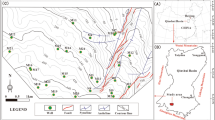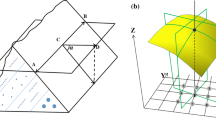In order to accurately predict the high-production areas in CBM reservoirs, we identified the main geological factors controlling the CHM production. Based on the statistical analysis data of the geological and production area and seismic prediction methods, the comparative influence of the five main geological factors was studied. The validity of the seismic prediction method was further evaluated. The results show that the production of a GEM well is influenced by the reservoir structure, gas content, permeability, and coal-body structure. The above four geological controlling factors can be accurately evaluated by the seismic attributes. The proposed high-production area seismic prediction method can be applied for accurate localization of the high-production areas. When the high-production evaluation index is lower than 0.2, the daily gas production exceeds 1000 The method can provide an effective instrument for evaluating formation productivity.





Similar content being viewed by others
Change history
19 March 2020
To the article ���Research and Application of High-Production Area Seismic Prediction Technology for High-Rank Coalbed Methane Reservoir,��� by Liu Yumin, Li Xuesong, Sun Yonghe, Li Minghui, Du Jingguo, Vol. 55, No. 5, pp. 606-614, November, 2019
References
X. Z. Zhao, Q. Z. Mu, and F. J. Sun, "Practice of coalbed methane exploration and development in Qinshui basin." J. China Coal Soc., 40(9), 2131-2136 (2015).
Q. Z. Zhu, Y. H. Yang, and Y. Q. Zuo, "CBM development in China: challenges and solutions," Nat. Gas Ind., 38(4), 96-100 (2018).
H. B. Wu, H. J. Xu, and P. S. Zhang, "Sweet-spot prediction for CBM reservoir based on seismic inversion parameters," Coal Sci. Technol., 46(7), 218-222 (2018).
L. H. Shao, C. Y. Liu, and Q. X. Ding, "Prediction of 11#coalbed gas content in Hancheng coalbed methane 3D seismic survey," Geol. Sci. Technol. Inform., 35(1),147-151 (2016).
X. M. Qi and S. C. Dung, "Application of seismic multi-attribute fusion method based on D-S evidence theory in prediction of CBM-enriched area," Appl. Geophys., 9(1), 80-86 (2012).
X. P. Chen, Q. M. Huo. and J. D. Lin, "The inverse correlations between methane content and elastic parameters of coalbed methane reservoirs," Geophysics,78(4), 237 - 248 (2013).
L. N. Huo, L. G. Xu, and L. H. Shao, "Seismic prediction technologies of CBM sweet spots and their application," Nat. Gas Ind., 34(8), 46-52 (2014).
W. F. Du and S. P. Peng, "Coalseam thickness prediction with geostatistics," Chin. J. Rock Mech. Eng., 29 (Supp.1), 2762-2767 (2010).
A. R. Gregory, "Aspects of rock physics from laboratory and log data that are important to seismic interpretation: Section 1. Foundamentals of straligraphic interpretation of seismic data,"AAPG Memoir 26, Seismic stratigraghy - Application to hydrocarbon exploration, 15-46 (1977).
A. C. B. Ramos and T. L. Davis, "3D AVO analysis and modeling applied to fracture detection in coalbed methane reservoirs," Geophysics, 62(6),1683-1695 (1997).
L. Ai, M. S. Zhou, and J. Zhang, "Quantitative identification of coal structure based on coal rock brittleness index by logging data," Larhot. Reserv, 29(2), 139-144 (2017).
X. Z. Zhao, S. Q. Liu, and S. X. Sang, "Characteristics and generation mechanisms of coal nes in coalbed methane wells in the southern Qinshui Basin, China," J. Nat. Gas Sci. Eng., 34, 849-863 (2016).
Q. J. Hu, H. M. Jia and K. J. Qi, "A fine control method of owing pressure in single-phase ow section of high-rank CBM gas development wells: A case study from the Fanzhuang-Zhengzhuang Block in the Qinshui Basin," Nat. Gas Ind. 38(9), 76-81 (2018).
H. Y. Wang, J. B. Mang, and J. M. Li, "Enrichment and reservoir laws of the coalbed methane in China," Nat. Gas Ind., 24(5), 11-13 (2004).
B. Wang. F. Y. Xu, and B. Jiang, "Studies on main factor coupling and its control on coalbed methane accumulation in the Qinshui Basin,"Energ. Explor. Exploit., 31(2), 167-186 (2013).
Y. Song. S. B. Liu, and Y. W. Ju, "Coupling between gas content and permeability controlling enrichment zones of high abundance coalbed methane," Acta Pet. Sini, 34(3), 417-426 (2013).
K. Wang. J. S. Dai, and H. G. Zhang, "Numerical simulation of fractured reservoir stress sensitivity: a case study from Kuqa depression Keshen gas field," Acta Pet. Sini, 35(1), 123-133 (2014).
Q. J. Hu, M. X. Li, and M. P. Qiao, "Analysis of key geologic factors of fracturing effect of CBM wells for high-rank coal in Southern Qinshui Basin," J. China Coal Soc., 42(6), 1506-1516 (2017).
Y. Chen, D.Z. Tang, and H. Xu, "The distribution of coal structure in Hancheng based on well logging data," J. China Coal Soc., 38(8), 1435- 1442 (2013).
D. Marroquin, "Seismic attribute-based characterization of coalbed methane reservoirs: An example from the Fruitland Formation, San Juan basin. New Mexico," Ame. Assoc. Pet. Geol. Bull., 88(11), 1603-1621(2004).
X. X. Fu, F. Xu, and Q. R. Qin, "Estimation of seismic wave energy attenuation gradient based on Pseudo-Margenau-Hill distribution,"Lirhot Resent. 23(6), 106-110 (2011).
Q. S. Tan, R. R. Zou, and J. Cui, "Research on geophysical comprehensive evaluation method of coalbed methane enrichment region-taking Zhengzhuang region for example," China Coalbed Methane,14(1), 15-20 (2017).
Z. P. Meng, S. S. Liu, and B. Y. Wang, "Study on feature of coal body structure and logging response in Jincheng Mining Area," Coal Sci. Technol., 43(2), 58-63,67 (2015).
Acknowledgement
This study was financially supported by the National Natural Science Foundation of China (Grant No. 41572127).
Author information
Authors and Affiliations
Corresponding author
Additional information
Translated from Khimiya i Tekhnologiya ropily i Mare!, No. 5, pp. 66— 70, September — October, 2019.
Rights and permissions
About this article
Cite this article
Turnip, L., Xuesone, L., Yonghe, S. et al. Research and Application of High-Production Area Seismic Prediction Technology for High-Rank Coalbed Methane Reservoir. Chem Technol Fuels Oils 55, 606–614 (2019). https://doi.org/10.1007/s10553-019-01073-x
Published:
Issue Date:
DOI: https://doi.org/10.1007/s10553-019-01073-x




